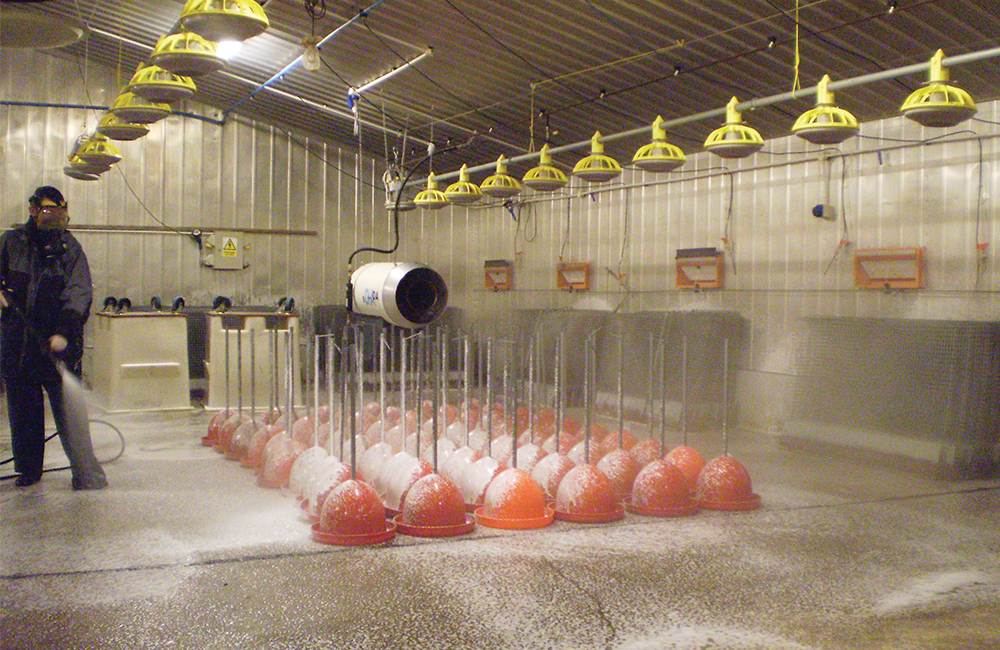Maintaining your biosecurity in egg production will help to protect your hens and customers from harmful germs and parasites. This will form an important part of your operation.
The most common causes of disease in chickens are viruses, bacteria, parasites (such as worms) and fungi (mould). Consider this when planning your health and security systems.
Your poultry management should include a comprehensive biosecurity plan, vaccine schedule, high quality diet and adequate housing.
The biosecurity component of your management should entail a combination of cleaning and disinfection, traffic and pest control and adequate carcass disposal.
To begin with, establish a written biosecurity plan and go over it with your staff. Ensure they are aware of all the steps required, and keep them up to date with any changes.
What are the biosecurity standards on egg farms?
Bacteria, viruses, etc can be carried into your chicken houses by you ~ or other people ~ and measures must be put into place to prevent this.
Everyone entering your chicken houses should wash their hands thoroughly before and after working on the property. This includes workers, delivery people and any other visitors.
Wear clean clothes in the houses to prevent the spread of disease. This includes making use of disposable hairnets, gloves and plastic boots (PPE). These items should be disposed of in a dedicated area of your property, away from the chicken houses and before anyone leaves your property. This will avoid the spread of anything from your property to another.
If you or your staff live on your property, you should have dedicated clothing to be worn in and around the poultry housing area. This includes footwear. Those staff living off the property should also have clothing designated for farm-use which should be removed before leaving the property.
Using a footbath
Place a footbath with disinfectant at the entrance to each chicken house. Ensure this is big enough for a set of large boots and that the liquid is at least 2-3cm deep. Use this bath on entry and exit, every time. Your footbath should be placed on a tarpaulin if your entrance is on a patch of bare earth or sand. If your bath is outside, it should be covered with a tarpaulin as well to ensure no rainwater or other foreign matter mixes with your disinfectant liquid.
The liquid should be changed daily and the bath cleaned regularly. Cleaning should include a thorough scrub with a strong bristled brush using a disinfectant soap. When disposing of the contents of your footbath, do so away from your production area and water sources.
An alternative to a footbath is dedicated footwear. These can be gumboots hung at the door of your chicken house, that are put on just before you enter and removed as you leave. This prevents the carrying of any harmful material away from your house. However, even these boots should be cleaned regularly with a disinfectant.
The equipment in your chicken houses should be disinfected regularly. This includes your cleaning tools. If you have purchased equipment from another property, it should be cleaned and disinfected very well before you introduce it to your property.
A high-pressure washer will be vital when managing biosecurity in egg production. Ensure you have a good quality one.

If vehicles are driving near your poultry houses, they should be disinfected before and after.
Delivery and transport equipment should be cleaned before and after each journey. This includes vans or trucks (inside and outside), crates, containers and any other equipment used in your travels.
Pest Control
You should limit exposure to rodents and flies. Do this through rigorous rodent and fly control programmes. Keep the doors to your chicken houses shut and locked, and block holes where rodents or wild birds might enter your house. Always be on the lookout for evidence of rodents or wild birds ~ rodent faeces and foreign feathers are a good indication of contamination. Do not allow wild birds to nest in the eaves of your houses.
Outside of your chicken houses, keep the grass low and the area clear of rubble and other debris that may be attractive to rats. Also ensure your feed stores are kept secure and clear of rodents. Any feed accidentally dropped on the ground should be cleaned up right away, even outside.
Standing water around your property, such as ditches allowed to fill with rain water or puddles caused by a leaking tap, can become a breeding ground for mosquitoes and other insects so should be prevented.
In general, your poultry houses should be for poultry only. Do not allow other animals such as pets or other livestock into the houses.
Vaccinations
Biosecurity in egg production should go hand in hand with a comprehensive vaccine schedule for your laying hens. Consult a vet to establish an adequate schedule to cover you against the most common illnesses, including Marek’s, Newcastle disease, Gumboro, infectious bronchitis, fowl pox and infectious laryngotracheitis. Luckily, some of these vaccines are combined and will require one administration to protect against more than one disease.
Some important factors to remember when you are establishing your vaccination plan:
- Take note of the temperature required for the vaccine’s storage;
- Check expiry dates;
- The number of doses mixed into drinking water, or sprayed onto the chickens, must correspond to the number of birds that have to be vaccinated;
- Keep a clear record of your vaccination administration.
Depending on the age of your hens, you will need to undertake a schedule of vaccines. Depending on whether you start with day-olds or point-of-lays your schedule will differ. It is best you consult a veterinarian on what will be needed and when in either case. If you have obtained point-of-lay hens, ensure the supplier gives you a clear record of what vaccines they did before you took ownership.
This is part four in a series on egg production. For more, click here.

